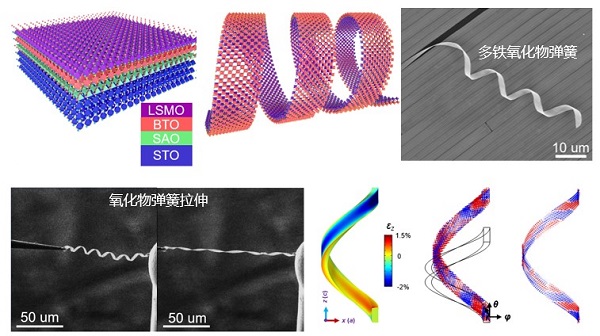XJTU researchers make important progress in stretchable ferroelectric oxides
Researchers from the School of Electrical Engineering, Xi'an Jiaotong University (XJTU), have constructed an oxide epitaxial heterojunction spring structure and found that the structure possesses highly stretchable mechanical properties.
The research was conducted by a research team led by Professor Liu Ming under cooperation with the team of Professor Peng Yong of Lanzhou University and the team of researcher Huang Houbing of the Beijing Institute of Technology.
This work realizes the exfoliation of the La0.7Sr0.3MnO3/BaTiO3 heterojunction by using water-soluble sacrificial layer technology. During the exfoliation process, the heterojunction is cleaved along the [110] direction so that the heterojunction film forms a nanoribbon structure which then spontaneously forms a spring structure under a lattice strain action.
The La0.7Sr0.3MnO3/BaTiO3 micro-nano springs can withstand great compressive and tensile deformations and exhibit excellent recoverable properties in in situ mechanical experiments. The phase field simulation results show that the axial and shear strains of the spring work together to produce lattice torsion, and the BaTiO3 layer is accompanied by continuous inversion of the ferroelectric domain structure.

Preparation, stretch ability and polarization evolution of La0.7Sr0.3MnO3/BaTiO3 spring structures
In this research, a functional oxide spring structure was constructed and found to have highly stretchable mechanical properties, revealing the evolution law of the ferroelectric domain structure during the spring stretching process, which provides important theoretical and experimental guidance for the development of stretchable flexible electronic devices based on ferroelectric/piezoelectric and magnetic oxides.
The above research results were published in Advanced Materials (IF=30.849) under the title Self-assembled Epitaxial Ferroelectric Oxide Nano-spring with Super-scalability. (Link to the paper: https://onlinelibrary.wiley.com/doi/10.1002/adma.202108419)
XJTU is the first unit of the corresponding authors. Assistant Professor Dong Guohua from the School of Electrical Engineering, Hu Yue, a master’s student from Lanzhou University, and Guo Changqing, a doctoral student from Beijing Institute of Technology, are the co-first authors. Professor Liu, Professor Zhou Ziyao, Professor Peng and researcher Huang are the co-corresponding authors.

